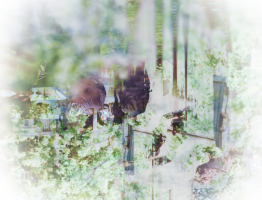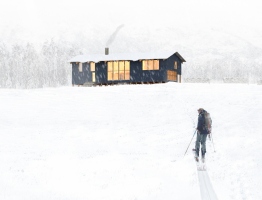Diploma project
Spring 2019
Institute of Urbanism and Landscape
Site Introduction
Sommarøy is a unique island in Troms county which can reached by bike and public transportation. It is famous for its white coral beaches and turquoise water.
It has been a famous destination for families living in Tromsø and surrounding areas. These people come here to camp on weekends to do multiple activities such as, kayaking, stand up paddling, taking a bath, enjoying the midnight sun and northern light… Seasonal activities of the island also attract many tourists during winter northern light and summer midnight sun. The municipality wants to expand the existing road and develop the island infrastructure to accommodate even more tourists in the island.
Project Introduction
This project is located at the at the waterside of Sommarøy island. Three selected sites have been disrupted by landfill for road construction, bridge infrastructure and developing camping site. These interventions investigate new edges for the beaches by addressing drift of material, transformation of the land and presence of people.
Three selected sites:
Beach number 1: The orientation of the first beach was disrupted due to heavy landfill for road construction. This road was built right over the old beach which limited the long white beach into a narrow white stretch just beside the road. High tide and storm surge are washing out the rocks with time meanwhile limiting the access to the beach.
The new concrete surface on this site holds the rocks behind it. Vegetations which are washed out during high water level will also remain there easier between the rocks. The structure makes the opportunity for Plants to accumulate more sand which will change the edge between the road and the sea by the time. This structure helps the sand and water to move on the surface instead of hitting the landfill. The access from the road to the beach is also possible on several openings.
Beach number 2: The orientation of the second beach was disrupted by the landfill for both industry and tourist camping site. The narrow remaining stretch of white sand is cut by the tick landfill edge to protect the land.
The concrete structure comes to hold the land while letting the beach grow over time. The structure provides pocket beaches during high tide when there is no access to the main beach. The structure helps to build up a green landfill which connects the beach to the camping site. It also gives access to different part of the beach.
Beach number 3: The orientation of the third site has been changing since bridge construction. Several beaches are gone under the pressure of landfills for developing fishing industry and tourism. This small pocket beach is the remaining part of those beaches. The high-speed narrow bridge is the only way to walk between two islands. People spend some time on the bridge to observe the landscape around.
The missing pocket beach is getting covered by rocks moving on the surface. This part of the road is eroding and needs a better structure. The structure helps the beach to show up between the infrastructures around it. It protects the road while giving access to the beach. It also provides a safer spot for visitors stopping by the bridge to observe the views around.

Sanaz Akbari Koli
Sommarøy is a unique island in Troms county which can reached by bike and public transportation. It is famous for its white coral beaches and turquoise water.
It has been a famous destination for families living in Tromsø and surrounding areas. These people come here to camp on weekends to do multiple activities such as, kayaking, stand up paddling, taking a bath, enjoying the midnight sun and northern light… Seasonal activities of the island also attract many tourists during winter northern light and summer midnight sun. The municipality wants to expand the existing road and develop the island infrastructure to accommodate even more tourists in the island.
Project Introduction
This project is located at the at the waterside of Sommarøy island. Three selected sites have been disrupted by landfill for road construction, bridge infrastructure and developing camping site. These interventions investigate new edges for the beaches by addressing drift of material, transformation of the land and presence of people.
Three selected sites:
Beach number 1: The orientation of the first beach was disrupted due to heavy landfill for road construction. This road was built right over the old beach which limited the long white beach into a narrow white stretch just beside the road. High tide and storm surge are washing out the rocks with time meanwhile limiting the access to the beach.
The new concrete surface on this site holds the rocks behind it. Vegetations which are washed out during high water level will also remain there easier between the rocks. The structure makes the opportunity for Plants to accumulate more sand which will change the edge between the road and the sea by the time. This structure helps the sand and water to move on the surface instead of hitting the landfill. The access from the road to the beach is also possible on several openings.
Beach number 2: The orientation of the second beach was disrupted by the landfill for both industry and tourist camping site. The narrow remaining stretch of white sand is cut by the tick landfill edge to protect the land.
The concrete structure comes to hold the land while letting the beach grow over time. The structure provides pocket beaches during high tide when there is no access to the main beach. The structure helps to build up a green landfill which connects the beach to the camping site. It also gives access to different part of the beach.
Beach number 3: The orientation of the third site has been changing since bridge construction. Several beaches are gone under the pressure of landfills for developing fishing industry and tourism. This small pocket beach is the remaining part of those beaches. The high-speed narrow bridge is the only way to walk between two islands. People spend some time on the bridge to observe the landscape around.
The missing pocket beach is getting covered by rocks moving on the surface. This part of the road is eroding and needs a better structure. The structure helps the beach to show up between the infrastructures around it. It protects the road while giving access to the beach. It also provides a safer spot for visitors stopping by the bridge to observe the views around.

Sanaz Akbari Koli




